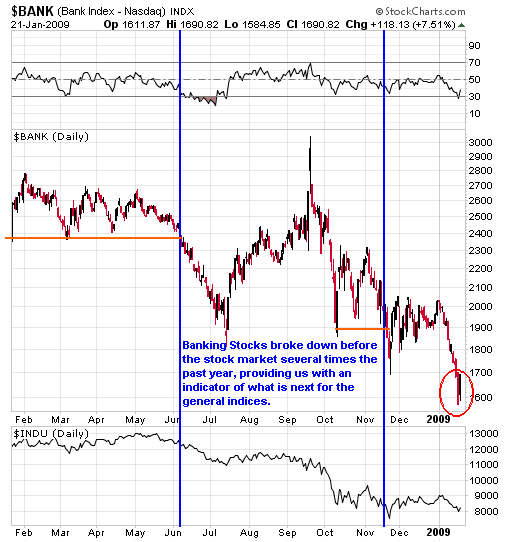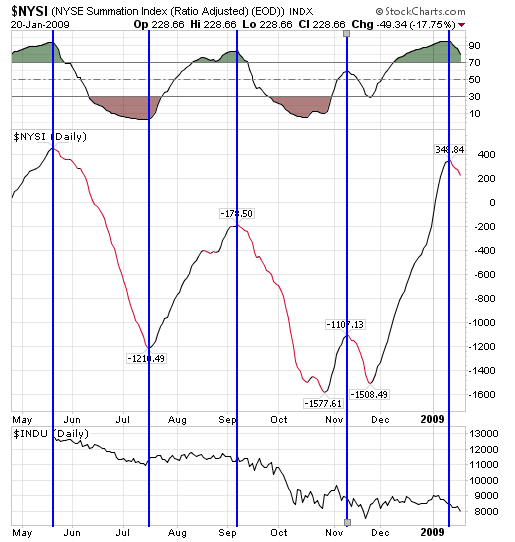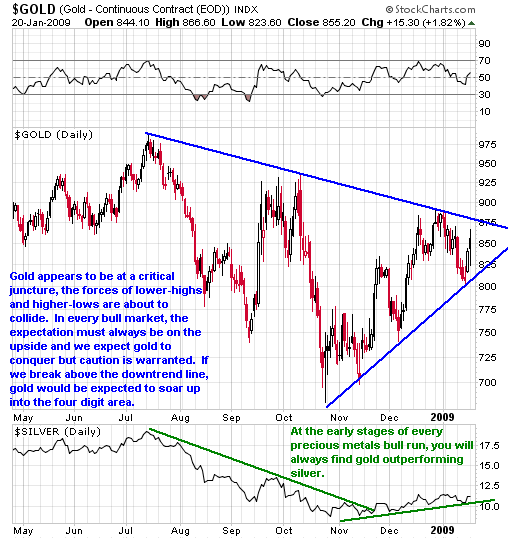Where the Stock Market, Gold and Silver are Headed Next
Stock-Markets / Investing 2009 Jan 22, 2009 - 05:39 AM GMTBy: Daniel_Smolski

 January 20th, 2009 probably one of the biggest days of this year, marked by several key new appointments. We have inaugurated our 44th president, Barack Hussein Obama, elected into office with the hopes that he will bring with him, a magic wand and resolve two decades of excess liquidity and derivative growth. A hope that will, undoubtedly, be shattered very quickly. Obama will simply continuing doing what actually start this problem and that is, print more money (or the new politically correct term, quantitative easing). The only ideal “solution” at this point, is for current government to successfully create another bubble somewhere.
January 20th, 2009 probably one of the biggest days of this year, marked by several key new appointments. We have inaugurated our 44th president, Barack Hussein Obama, elected into office with the hopes that he will bring with him, a magic wand and resolve two decades of excess liquidity and derivative growth. A hope that will, undoubtedly, be shattered very quickly. Obama will simply continuing doing what actually start this problem and that is, print more money (or the new politically correct term, quantitative easing). The only ideal “solution” at this point, is for current government to successfully create another bubble somewhere.
This band aid, patch up, job would simply prolong the evitable but it would be a “solution” nonetheless and we could all get back to our shopping malls and baseball games. For if a bubble is not created, there will literally be no way of repaying all the fiscal stimulus packages popping up all over the globe. It is not the principle that is of concerned, for I do not believe that will EVER be repaid, but going forward, even interests payments will be of concern. If these packages do not move the economy, you can mark my words, there will be dozens of countries defaulting. America is very quickly moving up the ranks in the list of candidates.
Another change of late is the replacement of Henry Paulson with Timothy Geithner. If there was one remarkably consistent indicator to trade off the past year, it was to sell before Henry Paulson spoke. As humorous and simplistic as it sounds, the market always conveyed its distrust of the man. This change is, without doubt, a positive but the question remains, how can Geithner be any different when all economist are calling for the same solution? The same people that failed to predict this crisis are the ones now responsible for fixing it. We are in unchartered waters, no one has been through this before, it is all guess work and the markets know it. Until there are some signs that the Fed has regained its footing and is having some success, do not expect the markets to respond well to any Treasury Secretary or other government official.
The markets of late have been acting more or less as anticipated. There was no bounce with the inauguration of Obama, which was probably seen as a disappointment to many but my belief is that his whole term will be seen as a disappointment. Not because of the man himself but because of the problems he has inherited. During recessions, the current president always gets blamed for the past presidents' mistakes. It leads to the never-ending growth of the social system, as current governments feel obligated to further multiple the welfare systems to help the needy. You can rest assured that the coming years will see the largest government growth on record. Given the crisis, it is a sad development as politicians tend to exacerbate problems rather than squelch them.
Currently the broad indices are continuing their grind toward the November lows. Much as anticipated, they have been slowly drifting towards 7500 on the DOW. If the market is set to retest, we do not believe it will fall much below the lows set two months ago.

After a couple weeks of consistent declines, the DOW is now working off its oversold condition. It is expected that the bounce may last a few more days before a continued decline towards 7500. Ideally, we would like to see several days of strong declines to create a panic bottom. This low could be made below November's but once it is established, it should kick off a large advance.
To be clear, we do expect to see new lows in 2009. We do not expect that this will be a year to buy and hold. Many attest to the theory that as January goes, so goes rest of the year. There is empirical evidence conveying that the theory holds true. No one is sure why but it is one of the most reliable indicators, with an almost 90% hit rate. Last year, January brought declines of about 6% and we ended down 40% at the end of December. Unfortunately, the performance of the first week of 2009 does not bode well for the rest of year. We are already down about 10% since the start of January. If the past is any indication, 2009 is set to make new lows.
Although we believe it is unlikely, our biggest concern is the possibility of the market simply rolling over and slicing right through the November lows. We say it is a concern because there are a few indicators that are hinting at that.
The first is the banking index. This stock market crash has been lead by the financials and following the banks as barometer the past year, gave us hints where the market was headed next. It has often lead in the break downs and served as a great “canary in the mine” to let us know if it is safe to get back in.

Observing bank stocks has often provided us with a few days advance warning of the where the stock market is headed. In the June, the sector broke down several weeks before the general indices. November provided us with a few days early warning. This is all makes sense, as banks are one the main culprits of this crisis and their stocks have rightfully been punished. An area of concern is the banking index has recently broken down below November lows. This should not be treated as outright evidence that the markets are about to tank but when investing, we must take everything into consideration. It is something that should be kept in the back of our mind going forward.
Another indicator that is currently flashing a warning signal is the summation index. It is derived from the McClellan oscillator and conveys how much money is moving in or out of the market. It is a useful tool to determine intermediate trends and as shown below, is often correct.

Viewing this chart in the short-term, makes it appear as though this indicator is flawless. However, do not perceive it as the holy grail of indicators, is just one tool out of a very large toolbox. If one expands the chart and analyzes it over the long run, it has a history of false signals but overall, it is usually on the right side of things. We believe this charts conforms with our short-term view that the market will continue to consolidate and head lower to the 7500 level. The slow decline could last several weeks, providing enough time for the NYSI to reach below zero, the point of neutrality. It must also be noted that historically, 350 is not very high, it appears this way because we have been in a bear market, where most of the action has been to downside.
History never repeats but always rhymes. It is an old adage that plays a critical role in investing. During the past few months we have been continually studying past crashes to find clues of how this one may unfold. At this juncture, one thing we have discovered is that declines, of the magnitude we just had, are always followed by significant rebounds (30%+). Unless we are in 1930s style, deflationary depression, we should look forward to a retracement of the recent crash. Even in the 1929, which was relatively the same sized decline as ours, the DOW had a nearly 50% bounce on the daily charts, from 200 to almost 300. We are simply unaware of a crash of over 40% to be followed by another double digit decline, without a sizable rally preceding it. Even if this bear market is not over, a significant rally is needed to lower fear and raise expectations, something that is measured by our next indicator.
The volatility index (VIX), is a great tool to evaluate complacency and fear in the markets. It is calculated using S&P500 index options and conveys investor sentiment and near-term volatility expectations. When the onslaught began last year, the VIX was trading in the low $30s, today it is holding well above $40. It does not mean that it is impossible for a strong decline to start here but it is unlikely, as investors remain wary. Market crashes occur during times of euphoria and excitement, those are the last two words that could be used to describe investor sentiment today.
The current times however, are anything but ordinary. All surprises, the past year, have been to the downside. If we do see a market crash, it will be a clear warning bell that this will be nothing short of the next great depression. For this reason, as a precaution, we have always recommended our subscribers hold a position in physical bullion at home. Not exchange traded funds (ETFs), or gold stocks but the physical stuff you can touch. All our positions in gold stocks, oil, and airlines are for purposes of earning capital gains, not for providing a safe haven during times of distress. The only thing that will protect you is real money, gold. If things were to really unravel, banking holidays are certain and a stash of monies is strongly recommended. These may seem like extreme measures but at times like these, it really is better to be safe, than to be sorry.

On the technical front, we can see that gold is nearing its downtrend line that has kept the lid on the precious metal since July of last year. A breakthrough will have significant bullish implications. We, however, must remain cautious as this area will bring in heavy selling. If the bears can be conquered than we look forward to $1000+ gold.
Historically, silver always has a tendency to underperform gold during the early stages of a run to new highs. This trend reverses as the bull matures and silver begins to dominate. In the end, silver always ends up outperforming gold, percentage wise. It is the same pattern of evolution with gold stocks. We first see the majors rise, then medium sized producers, and finally, the exploration companies. And once again, on a percentages basis, small exploration companies tend outperform but most of the gains are reserved for the last inning of the game.
The current market conditions are very difficult to compare to any other and as such, everyone must maintain a certain level of caution. It is no longer as simple as purchasing a random mutual fund and just waiting for it to go up. Investors today have to be aware of their investments and guard their hard earned money. We cannot be certain what the rest of the year holds for us but we can make educated predictions. The unlikely and worst turnout is that we break through November lows in a distinct fashion and form new lows, much lower, new lows. However, the most likely scenario is we continue muddling through the year, with a new market low at some point. However there are reasons to be very excited, as this year will probably be one of the greatest opportunities of the decade to establish new long-term positions.
Many sectors will bottom before the general indices and actually enter bull markets. The key to success, for the long-term, will be to position yourself correctly this year and be prepared to reap the rewards in the coming years. We will continue to monitor all sectors and point our subscribers to areas that we believe have the most potential going forward.
By Daniel Smolski
smolski@gmail.com - Smolski Investment Newsletter
For a limited time , we are opening our services to new subscribers and are currently offering a FREE trial to the Smolski Investment Newsletter. We had an extremely profitable year in 2008 but we strongly believe 2009 will be one of the best in a long time; those correctly positioned will reap the biggest rewards. In the next few weeks, we will continue to monitor the markets and specify which sectors are poised to provide the greatest returns. Do not hesitate to send us an email with “SIGN UP” as the subject line at smolski@gmail.com .
© 2009 Copyright Daniel Smolski - All Rights Reserved
Disclaimer: The above is a matter of opinion provided for general information purposes only and is not intended as investment advice. Information and analysis above are derived from sources and utilising methods believed to be reliable, but we cannot accept responsibility for any losses you may incur as a result of this analysis. Individuals should consult with their personal financial advisors.
Daniel Smolski Archive |
© 2005-2022 http://www.MarketOracle.co.uk - The Market Oracle is a FREE Daily Financial Markets Analysis & Forecasting online publication.


